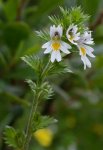Medulla
Euphrasia officinalis L.
Botanical characteristics. The family is nomadic. Annual herbaceous plant 30 - 50 cm tall. Stem straight, hairy, branched at the top. The ocellus parasitizes on the roots of other plants, feeding on their juices. Leaves opposite, dentate, ovate. Flowers are purple-lilac or white-violet, blossom in spring and autumn. Fruits - wedge-shaped boxes, ripen in August-September.
Spread.
It is widely distributed as a weed plant in orchards and gardens, on dry meadows and pastures, along roadsides.
It occurs in the European part of Russia and in Western Siberia.
Used parts of the plant.
The whole plant.
The plant contains essential oils (up to 0.17%), fatty oils, bitter substances, resins, blue coloring matter, gallotanins and glycoside aubcine.
Application. Ochanka is the best remedy in phytotherapy for the treatment of certain eye diseases. To do this, it is used inside as a water infusion and externally in the form of lotions. In addition, the focus is added to the mixture of herbs in heart diseases, gastritis and enterocolitis.
Preparation. 2 tablespoons of herbs are insisted with 0.5 liters of boiling water (daily dose). For lotions 4 tablespoons per 0.5 liters of water.
The popular homeopathic remedy Euphrasia 3x, 3, 6 is used mainly in the treatment of eye diseases. Characteristic symptoms: conjunctivitis, lacrimation, iritis, increased intraocular pressure, convulsive twitching of the eyelids, age-related impairment of vision. It is also effective in catarrh of the upper respiratory tract, accompanied by a runny nose, frequent sneezing and lacrimation. Euphrasia is indicated with irritable weakness of neurasthenics prone to hypochondria and arthralgia. It is also used as an external agent. Effective for blepharitis and conjunctivitis in the form of lotions - 5 drops of tincture on a tablespoon of water.




Comments
Commenting on, remember that the content and tone of your message can hurt the feelings of real people, show respect and tolerance to your interlocutors even if you do not share their opinion, your behavior in the conditions of freedom of expression and anonymity provided by the Internet, changes Not only virtual, but also the real world. All comments are hidden from the index, spam is controlled.